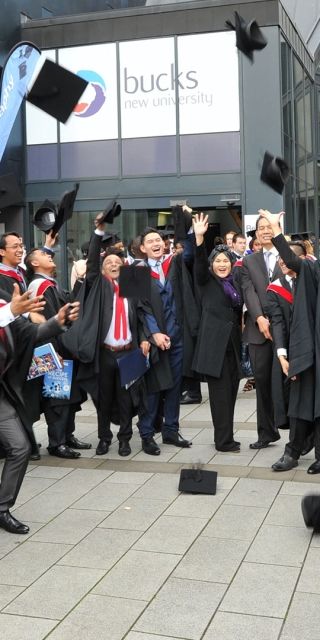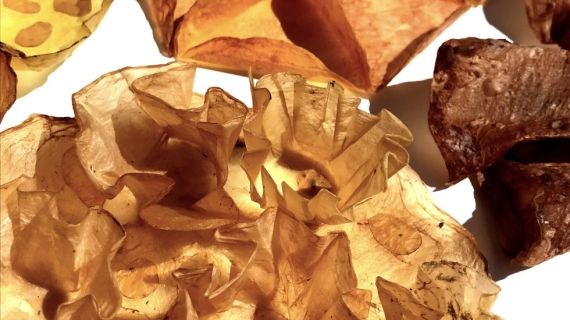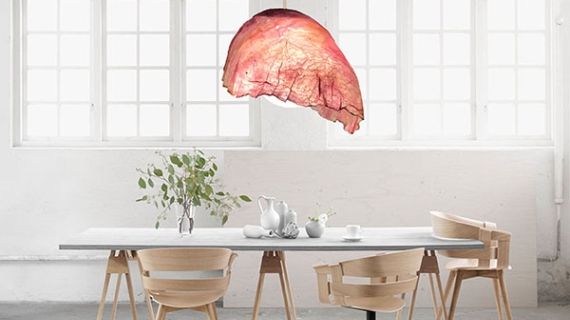
Emily's Story
Breadcrumb
Emily's Story
A career in biodesign - looking at integrating organic processes and materials in to the creation of our buildings, products, and clothing - could beckon for an environmentally-conscious Textile Design graduand.
Emily Hopkins says she has learnt plenty about the effects textiles can have on the environment during her final major project at Bucks, where she used Kombucha Leather, a type of vegan leather, to make lampshades.
Emily's work supported the University's Love Our Planet Day activity in 2020, where we marked Valentine's Day by pledging to go carbon net zero by 2030 - 20 years ahead of the Government’s target.
Now she says we could all help the environment by wearing clothing and using day-to-day items made using materials we grow ourselves, with any unwanted things thrown away in gardens for composting instead of being sent to landfill.
Emily's work is displayed as part of the 2020 Online Art and Design Show, which is available to see until the end of August.
She has told us all about her belief in her work and what she's looking to go on to do next.
So how pleased are you with your work, Emily?
I am very pleased with my final major project. My material experimentation and development was very thorough and revealed interesting results around bio-materials. There will always be more to explore but I am happy with my final samples and findings. I think they convey a powerful message about the potential of new materials and highlight a new way this vegan textile can be used.

Has it been difficult completing your work from home due to the Covid-19 outbreak and what particular challenges has this posed?
I managed the change from the university studios to home quite well and could continue most of my planned ideas / samples. Luckily there was a spare room I could set my experiments up in. Some processes, such as hand cutting my patterns instead of using a laser cutter, took longer at home. I did find it harder to focus at home, with many distractions, rather than the more controlled environments at the University. However, I produced a wide range of samples and two full research sketchbooks with content so I was happy.
Why did you choose to do the work you're displaying?
My biodesign exploration led me to my main material - Kombucha Bioleather - which all of my final pieces (including those being displayed) are made from. I chose to use this revolutionary material because of its versatility, sustainable properaties, and the innovation of using living organisms to create textile pieces. My designs are inspired by microorganisms with a modern geometric twist, suitable for interiors, and perhaps beginning to normalise the presence of useful bacteria in our homes and lives. 'Biofabrucation' is said by some to be the fourth industrial revolution, and I want to be part of this amazing change!

How excited are you about the future and which careers / areas do you want to go in to?
I hope to stay involved in the world of biodesign. This is a fast moving and exciting areas of textiles so it is necessary to stay updated with new developments. I am interested in going on to study a master's degree in the area to expand my knowledge. For now I am selling my more commercial designs and hoping to explore design across the world on my travels.
How have you benefited from studying at Bucks and what have been the most enjoyable parts of the course?
I have really enjoyed my time at Bucks and so happy to be leaving with a first-class degree. However, this is not the only thing I am taking away. I have many new transferable skills and much more confidence in myself and my work, along with great memories and life-long friends! The best parts of my course included getting to try out new textile equipment and techniques such as laser cutting, vacuum forming, printing, and metalwork. I also loved the theory side. Most of my projects are heavily research-based and I found it very interesting to learn about the wider impacts textiles has on societies and the natural environment.

- Picture caption 1: Emily Hopkins with paper, hand-made from stinging nettles, under a Kombucha Leather lamp.
- Picture caption 2: Kombucha Leather created using turmeric, beetroot, red cabbage, and Spirulina, a supplement and ingredient made from blue-green algae, as well as some of Emily’s lampshade designs.
- Picture caption 3: How one of Emily's lamps could look in a kitchen.